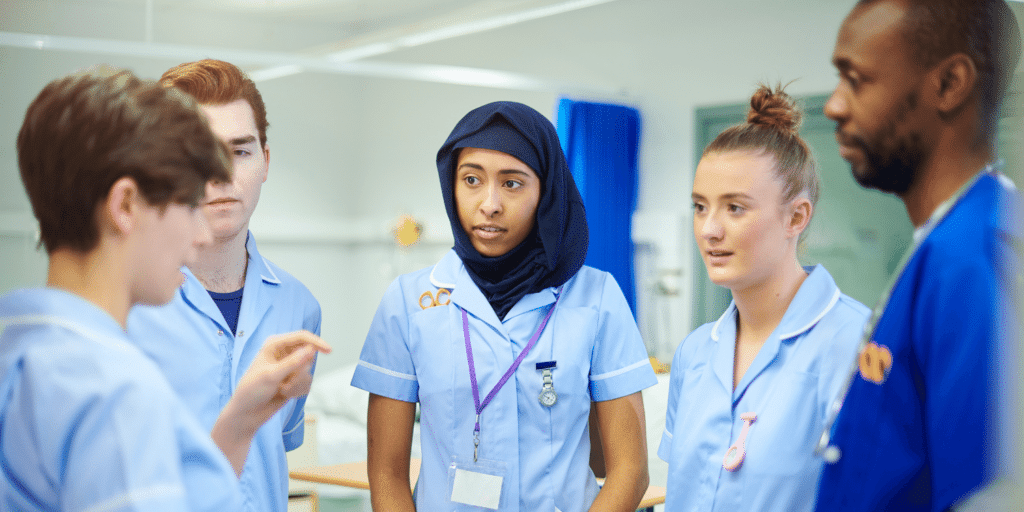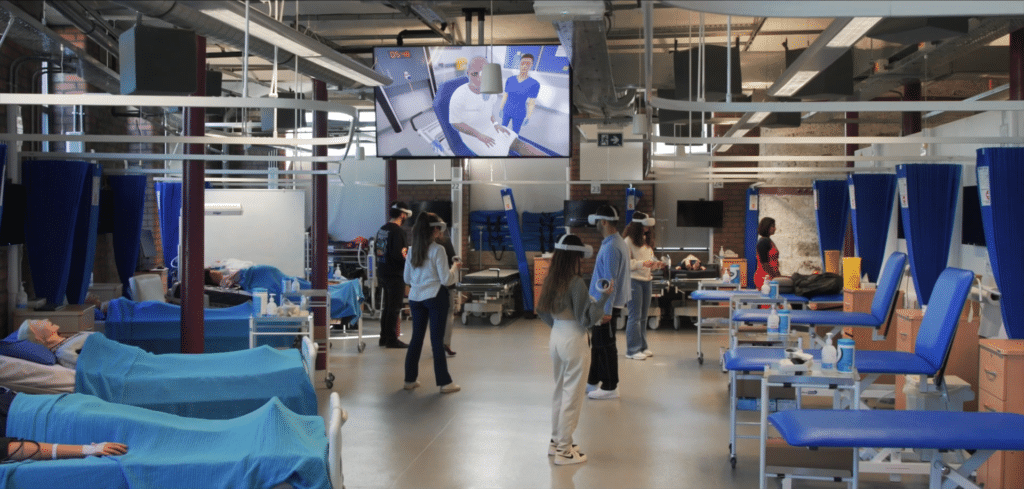In these uncertain times, universities and hospitals are being forced to reconsider how to train their learners and keep students on track to graduate or promote the next wave of healthcare providers.
For some, the question of how to supplement clinical hours with simulation has been an ongoing question or debate. Now, simulation is no longer a “nice to have” learning modality for programs but a “need to have”. Furthermore, live simulation is no longer an option for most so the question becomes, how can virtual simulation be used to supplement or replace lost clinical hours?
This is a question on so many minds at the moment and while the research and data to fully support this answer is still coming, there are several existing resources and theories around simulation-based education that can be used to help answer it.
Simulation is no longer a 'nice to have' learning modality, but a 'need to have'.
Can I use virtual simulation for clinical hour replacement?
First, there is the initial question of can virtual simulation be used to replace clinical hours at all? According to a statement released by Dr. Foronda (president of INACSL) and Bob Armstrong (president of SSH) the evidence and these organizations support the use of virtual simulation to replace clinical hours. This statement outlines the problem being that students may be blocked from graduating from their programs because of clinical hour requirements.
This ultimately comes down to the state policymakers but many states in the United States have already loosened the reins on these requirements to allow for flexibility. In a time where there are already shortages in medical personnel and now a pandemic on top of that, it is critical to support the training and promotion of these health care students to practicing health care professionals (doing so in a way that still provides them the best educational experience possible).
The next question for some whose state legislation allows high-fidelity simulation to replace clinical hours is: does virtual reality or virtual simulation count as high-fidelity simulation? The answer to that, based on the SSH definition of high-fidelity simulation is clear: Yes.
According to the SSH Dictionary, “high-fidelity refers to simulation experiences that are extremely realistic and provide a high level of interactivity and realism for the learner” which includes virtual reality.
Does virtual reality or virtual simulation count as high-fidelity simulation? The answer to that, based on the SSH definition of high-fidelity simulation is clear: Yes.

How much simulation equals clinical experience?
Now that we’ve established virtual reality and virtual simulation is high-fidelity simulation and there is evidence to support its use in place of live clinical experiences during this pandemic, the primary question has been how many clinical hours can be replaced with virtual simulation.
The answer to this depends on the source of virtual simulation, the resources provided before and after and the structure in which the simulations are implemented into the curriculum. The following is one example, using an OMS Distance nursing simulation scenario, in which one scenario could replace up to 4 hours of clinical. This same structure can also be used for the medical scenarios or interprofessional education scenarios depending on how they are implemented.
This example is based on using the INACSL Standards of Best Practice: Simulation Design and Debriefing to support prebriefing and debriefing activities before and after simulation. It is also using evidence from the 2019 study supporting 2:1 clinical to simulation hour ratio.
The following example was created starting with the simulation itself and working out (adding pre-simulation and post-simulation activities). Again, this is based on personal experience as a simulation educator, what is known about the standards of best practice and specifically using OMS scenarios as an example. These guidelines can be used for any virtual simulation and then can translate back to live simulation or live VR simulation (headset or HMD) when learners are able to return to campus.
To allow learners the opportunity to practice critical thinking and efficient patient care, each scenario is 20 minutes in length. Although the question of how long to debrief an experience has been debated, the research and best practice that I’ve always been taught is to debrief for twice the length of the scenario.
In this case, 40 minutes which can include the provided self-reflection and personalized feedback. In this example, 1 virtual OMS simulation scenario could equate to 1 full hour of simulation or clinical experience; however, there is much more that can and should be built into this simulation experience to increase the value as well as length of time.
How do I use deliberate practice in virtual simulation?
There are several simulation practices that can enhance the learning experience that can be incorporated into this timeline. First, deliberate practice which improves critical thinking, clinical judgment, decision making and confidence. An advantage of using virtual simulation, whether on screen or in a headset, is the ability to allow students to repeat scenarios as many times as they’d like (deliberate practice). This practice provides the personalized and individualized experience of running a scenario again and again without adding the time, space, or cost associated with running a live simulation again and again. In this example, it’s suggested to have the students run the scenario at least twice.
Can I use reflective pause/reflection-in-action?
Another tool that can be helpful in simulation-based learning is the reflective pause or focus on reflection-in-action. In this example, students are encouraged to reflect-on-action by reviewing the feedback and completing their reflection after the initial scenario. However, then by having students immediately return to the same scenario, now with the knowledge and insight gained from the first passthrough, they are better prepared to reflect-in-action during their subsequent experiences.
As previously mentioned, in this virtual reality simulation platform, students are prompted to do a self-reflection immediately after completing the scenario. Then, they are given personalized yet objective feedback based on their clinical decision making during the scenario. And finally, there is a place provided for students to then complete and document a proper self-debrief or self-reflection. In this example, students can take about 20 minutes to do this after the first session, then extend that time using additional activities and debriefing methods to 40 minutes after the second session. A full timeline breakdown is provided below.
How do I debrief virtual simulation?
According to the INACSL Standards of Best Practice: Simulation Design – criterion 8, each simulation should have a debriefing or feedback method and it should be consistent. While the self-reflection and feedback provided with OMS is based on the PEARLS method, there are several methods that can be used to debrief a virtual simulation.
In this example, at least 40 minutes should be used in the final debriefing session which gives educators time to allow students to review the objective feedback and then break into additional group debriefing. This group debriefing can be via video conferencing (ideal) or via a chatroom style classroom on a learning management system.
Additionally, students can be asked to complete a post-simulation activity to extend their learning experience and physical practice. For example, students can practice documenting their assessment from their virtual experience. On-screen virtual simulation (compared to headset/HMD VR) lends itself to this nicely as students can take notes as they go and catch missed items in their subsequent runs of the scenario. Documentation can be done in a note fashion or by using an EHR platform. EHR’s can also be created using Excel or Google Forms.
Another post-simulation activity option is to have students record themselves doing a shift-to-shift report based on the scenario. This report can then be posted to the LMS for peer review and feedback.
Depending on the scheduling ease or conflicts, a group debrief immediately following the simulation experience may not be possible (although debriefing immediately after the experience is ideal). In this case, students can complete the self-reflection and conduct a self-debrief using the feedback, guided questions and supplemental post-simulation activities. If a group debrief is scheduled for a later time, students can then review and bring with them their feedback to this group discussion.
To learn more about debriefing virtual simulations, see Simulation Canada‘s webinar “Virtual simulations: What are my debriefing options?
Should I pre-brief virtual simulation?
The last thing missing from this experience is prebriefing (INACSL Standard of Best Practice: Simulation Design, criterion 7) which does not have to look very different from prebriefing a live simulation experience. In live simulation, students may be provided with a room orientation, orientation to equipment, learning objectives, pre-simulation activities, a timeline, and the opportunity to ask questions. Using the LMS, students can be provided with learning objectives, pre-simulation activities or reading assignments, as well as a forum to ask questions and troubleshoot before their virtual simulation. Room and equipment orientation is then provided by OMS via videos to teach or remind students how to navigate the virtual scenarios and review the feedback. Educators or former students could also include a recorded shift report for students to review online prior to entering the OMS scenario.
The biggest foreseen difference between a live simulation prebrief and virtual simulation prebrief is that the responsibility and time required to complete this falls on the student. In this example, prebriefing time will be considered 20 minutes. To help guide and track students time, part of the prebriefing experience should be providing the students with the expected timeline for this experience. An example of this posted to the LMS may look like this:
Today’s Simulation Experience timeline:
- Please complete the pre-simulation activities (20 minutes)
- Complete simulation scenario – George, SNR101US (20 minutes)
- Review feedback and complete “My reflective practice” (20 minutes) – Reflection must be 3+ sentences and shared to faculty
- Repeat simulation scenario – George, SNR101US (20 minutes)
- Review feedback, complete “My reflective practice” comparing first attempt to second attempt, complete additional post-simulation assignment (group debrief, documentation assignment, individual debrief using worksheet or tool, etc) (40 minutes)
In this virtual simulation example, the 2 hour virtual simulation experience (based on a 20 minute scenario run twice with structured prebriefing before and debriefing after) would equal 4 hours of clinical time.
Final timeline review
In review, we’ve now taken a single virtual reality simulation scenario and structured it’s execution to equate to 2 hours of simulation time.
The final element of this “how much clinical time equals virtual simulation” debate is considering how much live simulation is considered clinical time. In this scenario, we are considering virtual simulation and live simulation time equivalent, although future research and data can hopefully help clear up whether that ratio is appropriate.
Due to the increased intensity and efficiency of simulation, evidence supports using a 1:2 ratio for simulation to clinical time. What this means is that for every 1 hour of simulation, students are given 2 hours of clinical time. In this virtual simulation example, the 2 hour virtual simulation experience (based on a 20 minute scenario run twice with structured prebriefing before and debriefing after) would equal 4 hours of clinical time.
This information, as well as a discussion and demonstration of the OMS Distance platform is also provided as a Webinar. To access the webinar or discuss this further with an Educational Specialist, please click below.
